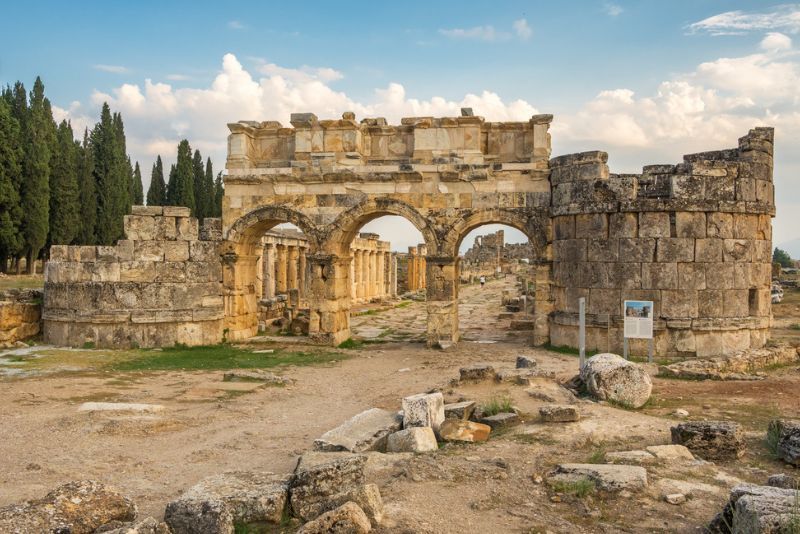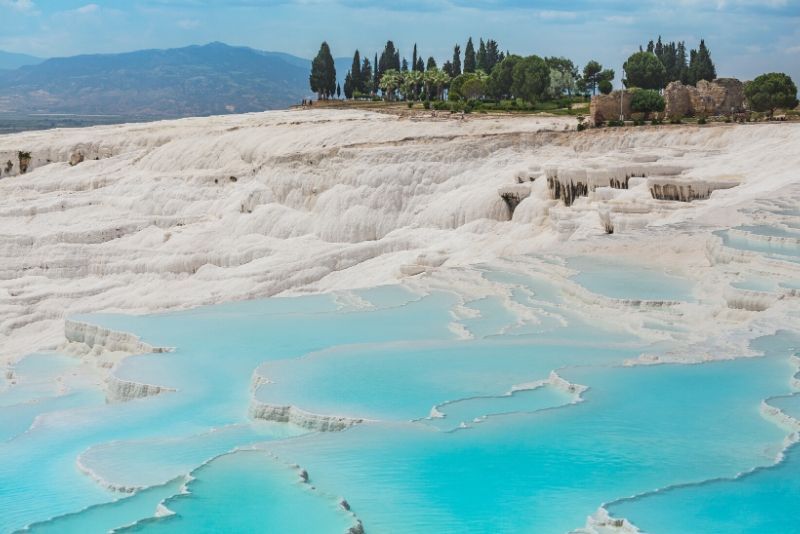Hierapolis: Day Trips and Tours from Marmaris
The port city of Marmaris lies along the turquoise Mediterranean shores of the Turkish Riviera. Known for its honey, this popular tourist destination has a long and fascinating history. Apart from its appeal as a beach holiday location, Marmaris is ideally situated for exploration further inland.
In the neighboring Anatolian province, the ruins of Hierapolis remain as a testament to the longevity of ancient Roman construction. The remnants of this once majestic spa city are comfortably accessible on an excursion.
The port city of Marmaris lies along the turquoise Mediterranean shores of the Turkish Riviera. Known for its honey, this popular tourist destination has a long and fascinating history. Apart from its appeal as a beach holiday location, Marmaris is ideally situated for exploration further inland.
In the neighboring Anatolian province, the ruins of Hierapolis remain as a testament to the longevity of ancient Roman construction. The remnants of this once majestic spa city are comfortably accessible on an excursion.

(0/24) checking Musement...
The port city of Marmaris lies along the turquoise Mediterranean shores of the Turkish Riviera. Known for its honey, this popular tourist destination has a long and fascinating history. Apart from its appeal as a beach holiday location, Marmaris is ideally situated for exploration further inland.
In the neighboring Anatolian province, the ruins of Hierapolis remain as a testament to the longevity of ancient Roman construction. The remnants of this once majestic spa city are comfortably accessible on an excursion.
A day trip to Hierapolis from Marmaris provides visitors with the opportunity to not only step back in time, but also to experience the otherworldly beauty of the sparkling terraces of Pamukkale.

Here's all you need to know about Hierapolis, one of the most exciting day trips from Marmaris.
How to get to Hierapolis from Marmaris?
Hierapolis is located to the northeast of Marmaris, in the Anatolian province of Turkey.
From Marmaris to Hierapolis by car
If your preference is to travel independently, you can self-drive to Hierapolis from Marmaris in under 3 hours. The 205-kilometer drive along the D330 takes you via Mugla and Denizli to Pamukkale and Hierapolis.
From Marmaris to Hierapolis by public transport
For travelers with time to spare, it is possible to travel as far as Denizli by bus. From Denizli, it is necessary to either catch a local minibus taxi, or book a private transfer to reach Hierapolis.
Guided tour to Hierapolis from Marmaris
Guided tours are the most cost-effective and convenient way of visiting Hierapolis from Marmaris. Full-day trips typically operate on a shared basis and include a hotel pickup, transport, a guide and some or all entrance fees.
Most tours are full-day activities, departing Marmaris early in the morning and arriving back after dark.
How much does the entrance ticket to Hierapolis cost?
A ticket to enter Hierapolis costs TL400 (approximately US$18). Your ticket provides access to Hierapolis and the adjacent site at Pamukkale. You can book tickets online or at one of the four access points: the North and South gates, the Walkway or the Antique Bath.
Parking incurs an extra cost of 20 Turkish Liras (approximately US$1).
Booking terms and conditions apply to online purchases and tickets bought on site are only valid on the day of purchase. A museum pass that allows entrance to multiple museums is also an option if you have plans to tour other sites.
What is the typical itinerary?

On a typical excursion from Marmaris, you will be collected from your hotel and will travel by air-conditioned minibus. Your guide will reveal the wonders of the region to you, pointing out places of interest as you travel. At Hierapolis and Pamukkale, you will visit the ancient ruins and view the mesmerizing white terraces formed over millennia by minerals seeping from underground hot springs.
There will be time on the tour to explore independently and a lunch stop will be included. Some tours also visit the island-like shores of Lake Salda for a walk along the white sandy beach at the edge of this crater lake that is one of the deepest in Turkey. After a memorable day, you will travel back to Marmaris in the evening.
What kinds of tours are available to go to Hierapolis?
Small group guided tours are the most common types of tours offered from Marmaris to Hierapolis. Pamukkale is usually also included in these day trips and other destinations may also be included depending on the length and type of tour.
Here are some of the most popular tours available:
Guided full-day tours to Hierapolis and Pamukkale from Marmaris

A guided tour from Marmaris to Hierapolis starts early and travels through the rugged Turkish landscape to the Anatolian province. Together with your companions, you will hear more about the history and myths that make this region so fascinating. Once you arrive, your guide will escort you as you explore the various sites in and around Hierapolis and Pamukkale.
Basic small group tours include transport and guide services with entrance fees and meals being at an additional cost. Other tours may also include meals and entrance fees.
Guided full-day tours to Hierapolis and Pamukkale plus Lake Salda from Marmaris
For a full day of touring that encompasses three of the area’s highlights, you can join a guided tour from Marmaris to Hierapolis, Pamukkale and Salda Lake. Your morning and early afternoon are spent at the UNESCO World Heritage Site that encompasses Pamukkale and Hierapolis.
In the afternoon, the excursion heads to Salda Lake where you can take in the views of the lake’s sandy white beaches and azure waters. This tour returns to Marmaris in the evening.
How much does a day trip to Hierapolis from Marmaris cost?
A basic full-day guided tour to Hierapolis from Marmaris starts at US$35 per person. This cost includes a hotel pickup and drop off, transport, a guide, and may include lunch on some options.
Guided tours from Marmaris to Hierapolis, Pamukkale and Lake Salda operate on a shared basis and cost from US$50 per person. Breakfast and lunch are usually included in this price.
What will you see and do?

Hierapolis is an ancient Roman and Byzantine city that was built around a series of mineral hot springs. It was known as a place of rest and healing and was held in esteem by the time’s most prominent citizens.
Many of the archaeological sites bear witness to the popularity and renown of the city including the great thermal baths, The Antique Pool and Cleopatra’s Pool, which were a central feature that included gymnasiums and libraries. You are able to view the remnants of these baths as well as places of worship such as the Temple of Apollo, gathering places like the Grand Roman theater, and final resting places such as the extensive grounds of the Necropolis.
Adjacent to Hierapolis are the travertine terraces of Pamukkale, also known as the “Cotton Castles” owing to their dazzling white structures formed by the mineral-rich waters from beneath the ground.
Salda Lake, one of the deepest freshwater lakes in Turkey, is a place of rest and relaxation. Here you can unwind on the white sands or take a refreshing swim in the calm, clear water.
What are the opening times?
Hierapolis is open daily, although some visiting hours may change if renovations or events are taking place. All entrances open at 8 AM with the exception of the South Gate which opens at 6:30 AM. The site closes at 9 PM in the summer and at 6 PM in the winter months. During the spring and autumn months, Hierapolis closes at 8 PM.
When is the best time to visit Hierapolis?
The best time to tour Hierapolis is in the spring (April to June) or autumn (September and October). The weather during these periods is generally moderate, and the site is less crowded than in the high summer months.
Alternatively, if your goal is to skip the tourist crowds completely, the winter months (November to March) may suit you. However, during this time, anticipate cooler weather and the occasional rainfall.
Are there any tours to Hierapolis from other cities in Turkey?
Yes, there are tours departing from other cities in Turky:
- Day trips to Hierapolis from Side
- Day trips to Hierapolis from Antalya
- Day trips to Hierapolis from Izmir
- Day trips to Hierapolis from Fethiye
- Day trips to Hierapolis from Kusadasi
- Day trips to Hierapolis from Alanya
Travel tips
- Due to the site's ancient terrain, it's recommended to wear comfortable shoes. However, to preserve the natural beauty of Pamukkale's travertine terraces, you are required to tread barefoot.
- During the height of summer, Hierapolis attracts a substantial number of visitors. To skip the crowds, consider arriving early in the morning or late in the afternoon.
- Temperatures can soar during the summer, so it's crucial to keep hydrated and bring along sun protection.
- For an extra fee, you can enjoy a unique swimming experience in Cleopatra's Pool while surrounded by submerged ancient columns.
- Lastly, don't miss a visit to the Hierapolis Museum, which showcases a wide array of artifacts unearthed in Hierapolis.
